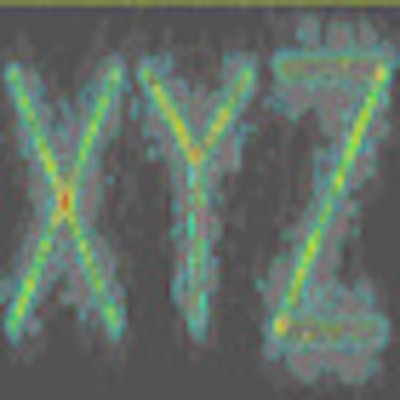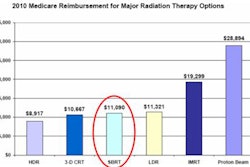

In order to realistically represent the beam delivery and dose deposition, however, such simulations require the ability to model continuously variable beam configurations and complex treatment geometry and kinematics. To this end, Julio Lobo, PhD, and Tony Popescu, PhD, have developed two new sources for the widely used DOSXYZnrc Monte Carlo code.
 |
| Monte Carlo dose distribution due to a CyberKnife beam moving parallel to itself and perpendicular to the plane of voxels shown in beam's eye view. Image courtesy of medicalphysicsweb. |
"I was more than aware of the challenges faced by those who performed Monte Carlo simulations of intensity-modulated arc therapy," Popescu explained. "For the last decade, the paradigm was to perform brute-force simulations, involving the reading, writing, storage, and transfer of hundreds of large 'phase space' and dose files, which render such simulations computationally prohibitive. My goal was to move toward quasicontinuous simulations, free of resolution limitations, and completely eliminate intermediate phase spaces."
Extensive approach
The sources -- referred to as Sources 20 and 21 -- support a continuously moving gantry, collimator rotation, variable monitor unit rate, couch rotation and translation, arbitrary isocenter motion, and variable source-to-axis distance, as well as dynamic multileaf collimator motion and dynamic jaw motion. These features make them applicable to Monte Carlo simulations for modalities such as RapidArc (Varian Medical Systems, Palo Alto, CA), Elekta VMAT (Elekta, Stockholm), and CyberKnife (Accuray, Sunnyvale, CA).
Source 20 uses a phase space input, while Source 21 uses a full BEAMnrc simulation as the input. According to the authors, one unique feature of these sources is the synchronization between the motion of the linac components (modeled in BEAMnrc) and the motion in the machine-patient geometry (modeled in DOSXYZnrc).
"With rotational/helical [intensity-modulated radiation therapy (IMRT)], we have to deal with an intricate interplay between the continuous motion within the machine head and the motion of the machine around the patient," explained Popescu.
In a clinical treatment plan, the position of each multileaf collimator leaf is precisely correlated with the gantry position at any given time. A Monte Carlo simulation, however, is a statistical sampling experiment with no associated natural time scale. Thus synchronization is achieved by time-stamping the particles -- taking a particle that passed through a specific multileaf collimator aperture and sending it into the patient from the gantry angle corresponding to that configuration.
"The only sources that can achieve this are 20 and 21," Popescu said.
Key comparisons
Lobo and Popescu validated the sources via comparison with results from existing source codes under equivalent geometric conditions. For example, they compared a seven-field head-and-neck IMRT plan simulated as a single arc using Source 20 with a field-by-field simulation using Source 2. The Source 20 simulation was achieved in a single run, while Source 2 required seven independent Monte Carlo runs. The two plans showed virtually identical dose distributions and dose-volume histograms.
They note that Source 20 is now used routinely at the British Columbia Cancer Agency in Vancouver for patient-specific RapidArc quality assurance. Dynalog files (containing multileaf collimator positions and gantry angles) recorded by the linac during beam delivery act as inputs to the Monte Carlo simulations. A typical Source 20 simulation takes four to six hours to run on 10 to 20 nodes of the institution's Monte Carlo cluster, leading to a statistical uncertainty of less than 1% in the high-dose voxels.
Comparisons of Monte Carlo results with ionization chamber measurements in a cylindrical phantom show typical differences of less than 1%. The researchers also saw excellent agreement between Source 20 calculations and dose calculations performed by the Eclipse treatment planning system (Varian Medical Systems).
"In principle, Source 21 would suffice for all Monte Carlo simulations," said Popescu. But in practice, he noted, routinely simulating the full linac head where not essential may prove computationally costly. Source 20 is ideal for RapidArc and tomotherapy, where the jaw setting is fixed throughout treatment. Other technologies, such as Elekta VMAT or the newly proposed dynamic tomotherapy, require the use of Source 21.
The researchers are currently developing a quality assurance process for Elekta VMAT, in collaboration with Toronto's Princess Margaret Hospital. Other potential applications of Sources 20 and 21 include a dual-source (kV and MV) for Varian's TrueBeam technology that models conebeam CT acquisition during RapidArc delivery using interlaced beam pulses; or multiple arcs with couch rotation for stereotactic radiosurgery and lung or liver stereotactic body radiation therapy with RapidArc.
"My presentation of the new source codes at the Monte Carlo Treatment Planning Workshop in Cardiff last October attracted quite a bit of interest and I have already received several requests for the source package," Popescu told medicalphysicsweb. "They will soon be added to the standard BEAMnrc/DOSXYZnrc distribution, to be available to any user of these codes."
By Tami Freeman
Medicalphysicsweb editor
September 8, 2010
© IOP Publishing Limited. Republished with permission from medicalphysicsweb, a community Web site covering fundamental research and emerging technologies in medical imaging and radiation therapy.





_p888_f1_thumb.png?auto=format%2Ccompress&fit=crop&h=167&q=70&w=250)













